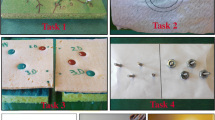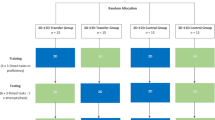Abstract
Performing minimal access surgery requires the use of 2-dimensional information to produce 3-dimensional movements, as well as precise motor control for manipulating laparoscopic tools. The added visuomotor demands of this task make it more demanding and complex than traditional open surgery. The purpose of this study was to determine the relative task difficulty of performing laparoscopic tool movements with normal vision or `laparoscopic vision' provided by a remote 2-D monitor. A second purpose of this study was to evaluate whether movement performance changes are induced by practice with normal vision (NV) and laparoscopic vision (LV). The study was also designed to determine whether order of visual condition (NV or LV) practice impacts the rate of performance acquisition when transferred to the opposing visual condition. Eleven individuals participated in this study. All subjects performed a bean grasping and a suturing task in two visual conditions: normal vision and laparoscopic vision. Results revealed that laparoscopic tools themselves do not appear to be problematic in performing minimal access surgery. Furthermore, performance ability in normal vision does not positively transfer to performance when switched to a laparoscopic vision condition. The 2-dimensional video does appear to be problematic for skill acquisition, as performance levels decreased as complexity of the task increased.
Similar content being viewed by others
References
Anastakis, D.J., Regehr, G., Reznick, R.K., Cusimano, M., Murnaghan, J., Brown, M. & Hutchison, C. (1999). Assessment of technical skills transfer from the bench model training model to the human model. The American Journal of Surgery 177: 167–170.
Crothers, I.R., Gallagher, A.G., McClure, N., James, D.T.D. & McGuigan, J. (1999). Experienced laparoscopic surgeons are automated to the ‘fulcrum effect’: An ergonomic demonstration. Endoscopy 31(5): 365–369.
Custers, E.J., Regehr, G., McCulloch, W., Peniston, C. & Reznick, R. (1999). The effects of modeling on learning a simple surgical procedure: See one, do one or see many, do one? Advances in Health Sciences Education 4: 123–143.
Derossis, A.M., Antoniuk, M. & Fried, G.M. (1999). Evaluation of laparoscopic skills: A 2-year follow-up during residency training. Canadian Journal of Surgery 42(4): 293–296.
Jack, R. & Starkes, J.L. (1999). A Psychomotor Examination of Suturing. Unpublished manuscript, McMaster University at Hamilton.
Proteau, L. (1992). On the specificity of learning and the role of visual information for movement control. In L. Proteau & D. Elliott (eds.), Advances in Psychology (pp. 49–66). Amsterdam, The Netherlands: Elsevier Science Publishers.
Reinhardt-Rutland, A.H. & Gallagher, A.G. (1996). Visual depth perception in minimally invasive surgery. In S.A. Robertson (ed.), Contemporary Ergonomics (pp. 160–180). London: Taylor & Francis.
Saeian, K. & Reddy, K.R. (1999). Diagnostic laparoscopy: An update. Endoscopy 31(1): 103–109.
Starkes, J.L. (1993). A stitch in time: Cognitive issues in microsurgery. In J.L. Starkes & F. Allard (eds.), Cognitive Issues in Motor Expertise (pp. 225–240). Amsterdam, The Netherlands: Elsevier Science Publishers.
Torkington, J., Smith, S.G.T., Rees, B.I. & Darzi, A. (2000). The role of simulation in surgical training. Ann R Coll Surg Engl 82: 88–94.
Author information
Authors and Affiliations
Corresponding author
Rights and permissions
About this article
Cite this article
Perkins, N., Starkes, J.L., Lee, T.D. et al. Learning to Use Minimal Access Surgical Instruments and 2-Dimensional Remote Visual Feedback: How Difficult is the Task for Novices?. Adv Health Sci Educ Theory Pract 7, 117–131 (2002). https://doi.org/10.1023/A:1015700526954
Issue Date:
DOI: https://doi.org/10.1023/A:1015700526954




